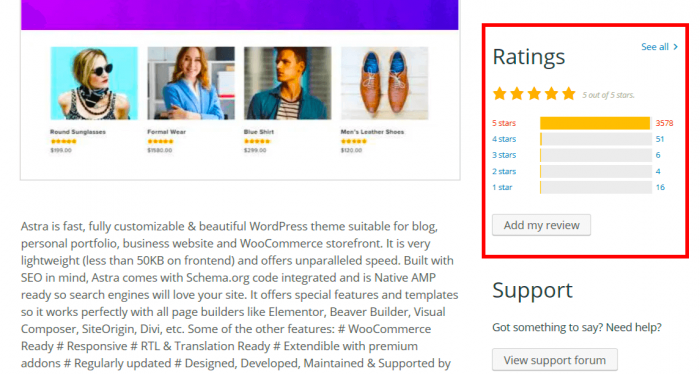Press ESC to close
A Big Hub Of Quality WP Themes
The Best WordPress Themes

The Comprehensive WordPress Theme Guide
What is a WordPress Theme?
When you start creating WordPress websites, you will begin to encounter themes. A theme in WordPress is simply a collection of templates and stylesheets that help to define a WordPress website’s Appearance and display.
You can easily change, manage, and add them from the WordPress admin area under Appearance, then Themes. WordPress offers an extensive collection of free and paid themes in its directory.
Each one comes with its own unique design, layout, and features. All a user need do is to choose the one that suits their website’s taste and requirements. These themes serve specific websites, which include photography, medicine, art, technology. These themes are designed for these particular services.
These themes can be modified by the addition of plugins or through the addition of codes to the functions.php file. Another form of change can be made in the form of a child theme. Themes consist mostly of three parts in addition to images and JavaScript files. These three parts include the style.css file, the template files, and a functions.php file, which is optional and allows changes to be made to the theme.
There must be a unique style.css file for every theme. This is not to say that the styles can be the same, but rather the header identifying information has to be different, or else there will be problems in the installation process. If the theme is not a child theme, then it has to have at least one index.php template that helps to control the display of content.

Free vs. Paid WordPress Themes
There are thousands of WordPress themes from the WordPress theme directory, and just like WordPress plugins, you can choose free ones or invest in the premium theme.
However, when picking between a free or a paid theme, it is much more than just picking what looks good but choosing something that works well for your website and the goals you intend to achieve with your content.
A free theme is great if you are starting a personal blog, don’t care about having a unique site, want just the basic functionality, can get by with little support, and so on. But if you are after something more, then premium themes are the way to go.
Premium themes offer the same advantages as premium plugins.
With premium themes, you have a reliable codebase and dedicated support if you need help with anything. Some premium themes operate like website builder software, allowing you to design and build your own unique theme designs and page layouts.
Premium themes are for those who want to build a business website with WordPress or thinking of expanding WordPress website functionality like ecommerce as time progress, want a unique website, want a website that can support several features, struggling to fix issues and need a dedicated support team.

How to choose the Perfect WordPress Theme – Things You Should Consider
It can be overwhelming for beginners when it comes to selecting a theme for their WordPress site. There abound thousands of free and paid options. Each theme is uniquely different from the other.
You should be careful when you are searching for the proper WordPress theme because each theme caters to different markets. Whatever theme you go for should complement your website content. For instance, if you are starting a blog that deals with political and social issues, the perfect theme to use is one with great readability.
Many WordPress themes come with several customization options. If they are not well coded, these options make it hard to change themes or use other WordPress plugins. Also, some WordPress themes might look great and sleek but could make your website really slow.
No one likes slow websites, more so for Google, which prefers to rank websites with faster speed.
Having said that, let’s look at some of the things you need to have in mind when settling for the best WordPress theme for your website.
1. Go for Simple
With many WordPress themes, you’ll find colors, flashy animations, complex layouts, etc. Sometimes, these things are useful, but oftentimes, you don’t really need them. According to Leonardo Da Vinci, “Simplicity is the ultimate sophistication.” and this is very true for WordPress themes.
Look for a theme with a design layout that meets your desired goals. While the theme should look good, it should not compromise on usability and simplicity.
Ensure that the theme’s presentation style is simple, as well. Website users want to be able to find information easily, and site owners need to achieve their goals at the same time.
Also, if a theme looks great but is not helping you get new subscribers or business, then it’s not really a great theme. It cannot also be called a good theme if users find it difficult to navigate your website.
2. Responsive is Not Optional Anymore
Today, with a large portion of web traffic coming from mobile and other handheld devices, it is all so necessary that your WordPress site is responsive, and based on your topics, you could have more than 50% of your traffic coming from these sources.
Google shows the top website in search results are mostly those that are mobile-friendly.
Regardless of your site’s topics and demographics, your website needs to be responsive and fully mobile-ready.
By default, most WordPress themes are responsive. But there are still sellers who sell fixed-width layout that is not at all mobile-friendly. You have to be careful to avoid those and ensure that the theme you choose for your website is mobile-friendly.
3. Testing a Theme for Mobile Readiness
The easiest way you can test for mobile responsiveness on your PC is by resizing your browser screen. As the screen of your browser resizes, you will notice that the theme’s layout automatically adjusts as well to fit the screen width.
But if you want to do a more thorough test, you can copy the theme’s demo page URL and paste it into Google’s Mobile-Friendly Test link page. Keep in mind that there might be some warnings shown on this test, regardless of how good a theme really is.
Look out for red flags like too-small text, content wider than the screen, and so on.
4. Browser Compatibility
You will have users who access your website through different browsers. While your theme may look perfect on your browser, but in other browsers, something might be broken.
This is why browser compatibility is essential. Most WordPress theme developers test their themes very well by using state-of-the-art tools for testing browser compatibility.
They may state this clearly on their website or not. If they don’t state it, you can always run simple checks to see how they work on different browsers like Google Chrome, Mozilla Firefox, Internet Explorer, Safari, etc. Also, remember to test across browsers on mobile as well.
5. Plugins that are Supported
The real power of WordPress comes with its plugins. With these plugins, you can do just about anything with your WordPress website. While WordPress plugins are many, the real power of WordPress comes from the must-have plugins for websites.
These include Gravity Forms, Yoast SEO, W3 Total Cache, and more. Ensure that whatever WordPress theme you go for supports all the popular plugins. If you aren’t sure, then ask your theme developer about it.
6. Translation + Multilingual Ready
Many WordPress sites are not in English Language. If you are creating a website in a language that is not in English language or you plan to create multiple versions of your website with some in other languages, then you should ensure that your WordPress theme is translation ready and supports multilingual WordPress plugins.
7. Page Builders
These are basically WordPress plugins that give the ability to create custom pages by using a drag and drop user interface.
Many premium WordPress comes with pre-installed page builders. For some, only the theme developer uses that specific page builder.
If you use such page builders, you will create pages that can produce a lot of unnecessary code. This means you will be doing a lot of cleaning up on those pages if you ever switch themes.
You should choose themes that choose with popular and industry-trusted page builder plugins. These page-builders can also be purchased separately to use with other themes as well.
8. Support Options
One downside of using free WordPress themes is that you will not be able to access guaranteed support. Although some developers offer excellent support for their free themes, many others offer no support option for their themes.
If your WordPress theme becomes messed up, then you are on your own figuring things out. You may end up having to pay third-party developers for even the smallest problems.
Ensure that you select a WordPress theme with good documentation and support options. There is detailed documentation offered with most premium WordPress themes with up to one year of email-based support.
9. SEO Friendliness
When it comes to your site’s SEO friendliness, your WordPress theme plays a crucial role. A good looking theme can actually generate a poorly coded HTML. This could negatively affect the performance of your site on search engines.
For beginners, analyzing a theme’s source code on their own might be difficult. This is the reason many premium WordPress theme developers let you know that their pages are SEO optimized.
If you want to see if the page generates a proper HTML5, then check it with W3C Markup Validation Service. However, note that with the W3C tool, you might get many warnings, but they are nothing to be worried about.
10. Ratings and Reviews
One indicator of the quality of a WordPress theme is the user ratings and reviews. If the theme is being sold on a third-party marketplace, you will find customer reviews as well.
For free WordPress themes, there is a rating section just below the download button. Here, you will see how many reviews and stars users have dropped for that theme. When you click on the 5-stars, then you can see the 5-star reviews that were given.

You will find that virtually all WordPress themes have bad reviews, but if there are more bad reviews than good for a theme, then you should tread carefully with that theme.
The Best and Popular WordPress Themes of 2020

The Best and Most Popular WordPress Page Builders (Drag & Drop) for 2020
Elementor
Elementor is the ultimate and free WordPress page builder that makes it possible for you to create a beautiful WordPress website in the quickest and easiest way possible. Elementor has replaced the basic WordPress editor with a live frontend editor. With it, you can reach a high level of design while designing real-time and from the frontend of your site.
You can visually complete complex layouts, and design your website live without the need to switch between the editor and preview mode. With the page builder, you can reach top-quality of design without having to code or use CSS, and without the need of help from developers.
The user interface is very user-friendly, so it takes a few minutes to get the hang of the page builder. Since its launch on June 2016, it has been frequently updated to run in the best mode and fast responding. The core plugin of Elementor is free, but Elementor Pro starts at $49 per year for 1 site, $99 for 3 sites, and $199 for unlimited sites.
Divi
Divi Theme Builder is a website templating system that allows you to use Divi Builder to structurer your website or to edit any part of the Divi Theme, which includes a header, footers, post templates and more. Each Theme Builder templates comprises of a header, footer, and body layout.
You can build and customize these three areas with Divi Builder as well as its full set of modules along with Dynamic Content. Some things that can be done with Divi Theme Builder include designing a global header/menu for the entire site, designing a global footer for the entire site, build a custom 404-page template, build a custom product page template, build a custom template for archive pages, design custom templates for all posts, etc.
Beaver Builder
Beaver Builder is a feature-rich drag-and-drop page builder plugin that makes creating great-looking content in WordPress stress-free. Beaver Builder makes it possible to build custom posts and pages, design without writing any code, see the results right as you tweak your website, and more.
Beaver Builder’s main selling point is its ability to make working with website content faster and efficient. One of the main issues with the WordPress platform that Beaver Builder tackles is the fact WordPress can be unfriendly to users who have no experience with websites, especially those looking to create custom websites according to their taste.

How To Customize WordPress Theme [Guide] 2020
WordPress comes loaded with features that make customizing easy. To get started with creating a beautiful and professional-looking website is to use the thousands of WordPress themes available in the dashboard.
WordPress Theme Frameworks form the foundation of many themes, built on a framework, rather than from scratch. There are two categories of this framework. One is developed by an organization for their specific theme shop, and the other are those that can be freely used for projects. Here’s a guide to customizing a WordPress theme.
Choose your theme
The first thing you’ll have to do is chose a theme that fits your specific needs. This theme should have the functionality needed for your project. Check the options the theme offers before creating a child theme. This is crucial, especially if this is your first time. Finding a theme that comes with features you need will save you a whole lot of time.
Customizing WordPress theme
A WordPress theme can be customized in several ways. Here are the popular and easiest ways to do this:
Using the WordPress Customizer
You can customize any WP theme by using the inbuilt customizer. However, you need to understand this tool first. The customizer can be accessed in the admin section.
To get it, go to Appearance > Themes > Customize. With this, you can modify your selected theme in real-time. However, note that the extent to which you can use this feature is based on how much effort the theme developers have put into its utilization.

On the customizer, you can change several things like theme color by clicking on ‘Colors.’ In the ‘Site Identity’ tab, you can change the site logo or icon. You can configure your site appearance, and modify background images and manage site menus. You can preview your website in different modes across device views to test site responsiveness.
Using Custom CSS
If you are just starting out, the Customizer has an inbuilt CSS editor you can try or the custom CSS that comes with the Jetpack plugin. This can be accessed in Appearance > Edit CSS.
You will find plenty of plugins that will help you write customized style sheets. If you are already familiar with CSS a bit, you can try the Advanced CSS editor, which allows you to implement across different devices such as desktop and mobile.
Using Plugins
Often, plugins help us to make the changes we seek. With them, we can alter the style and functionality we require but unable to create as beginners to WordPress. There are several plugins which are available for free, and developer usually create these wonderful add-ons that make it possible to change the look or functionality of your website style.
Sometimes you might get basic features for free, and if you want more exciting features, you will pay a small fee. Plugins allow you to:
– Alter visual elements if you know nothing about CSS or cascading style sheets.
– Add or delete blocks from pages even from the site’s front end.
– Drag and drop page builders such as Elementor and Beaver, etc.
Several ways exist for making theme modifications, but only try that once you’ve got the hang of WordPress. WP sites can be a bit tricky just for this reason, but when customized, they look better, are more scalable, and operate more efficiently.
Wrapping It Up
WordPress themes enable our website however we want. There are different directories we can go to get themes (both free and premium), or we could contact a professional designer and ask them to create our very own custom theme.
But no matter where you get the theme, the most important thing is to know what using one or another means for you by considering factors such as price, support, features, and more.






